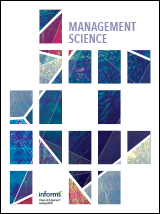Academic articles
Practitioner articles
Working papers
Books
Book chapters
Case studies
Other publications
Subject(s)
Product and operations management
Keyword(s)
Inventory management, price fluctuations, random selling price, doubly-stochastic Poisson process, modulated demand process
We study the optimal inventory policy of a firm selling an item whose price is affected by an exogenous stochastic price process which consequently affects customer arrivals. This case is typical for retailers that operate in different currencies, or trade products consisting of commodities or components whose prices are subject to market fluctuations. We assume that there is a stochastic input price process for the inventory item which determines purchase and selling prices according to a general selling price function. We also assume that unit demands arrive according to a doubly-stochastic Poisson process which is modulated by the stochastic input price process. We analyze optimal ordering decisions for both backorder and lost-sale cases. We show that under certain conditions a price-dependent base stock policy is optimal. The models are then extended to a price-modulated compound Poisson demand case. We present a numerical study on the sensitivity of the optimal profits to various parameters of the operational setting and stochastic price process such as price volatility, customer sensitivity to price changes etc. In another numerical setup, we compare the model with a corresponding discrete-time benchmark model that ignores within period price fluctuations and present the optimality gap when using the benchmark model as an approximation.
With permission of Elsevier
Volume
212
Journal Pages
139–152
Subject(s)
Economics, politics and business environment
Keyword(s)
School feeding, learning, midday meal, primary school education
JEL Code(s)
I21, I25, O12
Volume
139
Journal Pages
249–265
ISSN (Print)
0304-3878
Subject(s)
Information technology and systems
Keyword(s)
Hardware reverse engineering, hardware Trojans, hardware Trojan detection
Volume
16
Journal Pages
498–510
ISSN (Print)
1545-5971
Subject(s)
Human resources management/organizational behavior
Keyword(s)
Age, innovative behavior, inter-departmental collaboration, personnel outcomes
Although the topic of aging at work is receiving increasing research attention, it remains unclear if aging employees are less innovative at work and what consequences this relation entails. We integrate the literature on aging with research on innovation to gain a better understanding of whether—and if so, when—employees’ aging harms their professional outcomes via decreased innovative behavior. Multi-source, time-lag data on 305 project managers provides support for the idea that age does not always go hand in hand with low innovative behavior and, subsequently, low professional outcomes. Rather, inter-departmental collaboration works as a social buffer for these negative effects. Specifically, aging employees with low inter-departmental collaboration are less innovative and subsequently less successful. In contrast, the “age handicap” vanishes when aging employees collaborate with other members in their organizations. Our results highlight the importance for organizations to foster collaboration among their members, either formally or informally.
© 2019 Wiley Periodicals, Inc.
Volume
58
Journal Pages
301–316
Subject(s)
Strategy and general management; Technology, R&D management
Keyword(s)
Crowdsourcing, innovation, tie formation, networks, rejection
When organizations crowdsource ideas, they ultimately select only a small share of the submitted ideas for implementation. Organizations generally provide no feedback on ideas they do not select. Contributors whose ideas are not selected for implementation tend to forego submitting ideas in the future. We suggest that organizations can increase contributors’ willingness to submit ideas in the future by giving a thus far understudied form of feedback: rejections. Drawing on social network theory, we develop the overarching argument that rejections lead contributors to bond with the organization, increasing their willingness to continue to interact with the organization. While it may be counterintuitive to associate rejections with bonding, we hypothesize that rejections indicate to contributors that the organization is interested both in receiving their ideas and in developing a relationship with them. This effect, we argue, is particularly pronounced when rejections provide newcomers with explanations that suggest to them that they and the organization are a good match. To test our theory, we examine the crowdsourcing efforts of 70, 159 organizations that receive ideas from 1,336,154 contributors. Using large-scale content analysis, we examine differences in how rejections are written in order to disentangle the mechanisms through which rejections affect contributors’ willingness to continue to interact with an organization. We find that getting a rejection has a positive effect on a newcomer’s willingness to submit idea in the future. The effect is stronger if the rejection includes an explanation, and is particularly pronounced if the explanation accompanying the rejection matches the original idea in terms of linguistic style.
With permission of the Academy of Management
Volume
62
Journal Pages
503-530
Subject(s)
Product and operations management
Keyword(s)
Health care, contracting, fine balance matching, service value chain
Maintenance service plans (MSPs) are contracts for the provision of maintenance by a service provider to an equipment operator. These plans can have different payment structures and risk allocations, which induce various types of incentives for agents in the service chain. How do such structures affect service performance and service chain value? We provide an empirical answer to this question by using a unique panel data covering the sales and service records of more than 700 diagnostic body scanners. We exploit the presence of a standard warranty period and employ a matching approach to isolate the incentive effects of MSPs from the confounding effects of endogenous contract selection. We find that moving the equipment operator from a basic, pay-per-service plan to a fixed-fee, full-protection plan not only reduces reliability but also increases equipment service costs. Furthermore, that increase is driven by both the operator and the service provider. Our results indicate that incentive effects arising from MSPs leads to losses in service chain value, and we provide the first evidence that a basic pay-per-service plan—under which risk of equipment failure is borne by the operator—can improve performance and reduce costs.
Copyright © 2019, INFORMS
Volume
65
Journal Pages
955–1453
ISSN (Online)
1526-5501
ISSN (Print)
0025–1909
Subject(s)
Economics, politics and business environment; Management sciences, decision sciences and quantitative methods
Keyword(s)
Risk preferences, development, prospect theory
Volume
86
Journal Pages
1–21
Subject(s)
Human resources management/organizational behavior
Keyword(s)
Accuracy, social projection, cultural values, collectivistic vs. individualistic value
Volume
49
Journal Pages
47–62
ISSN (Online)
1099-0992
Subject(s)
Product and operations management
Keyword(s)
Legislation, product recovery, remanufacturing, recycling, end-of-life products
This paper presents an analytical framework of the product take back legislation in the context of product reuse. We characterize existing and proposed forms of E-waste legislation and compare their environmental and economic performance. Using stylized models, we analyze an OEM’s decision about new and remanufactured product quantity in response to the legislative mechanism. We focus on the 2012 waste electrical and electronic equipment directive in Europe, where the policy-makers intended to create additional incentives for the product reuse. Through a comparison to the original 2002 version of the directive, we find that these incentives translate into improved environmental outcomes only for a limited set of products. We also study a proposed policy that advocates a separate target for the product reuse. Our analysis reveals that from an environmental standpoint, the recast version is always dominated either by the original policy or by the one that advocates a separate target for the product reuse. We show that the benefits of a separate reuse target scheme can be fully replicated with the aid of fiscal levers. Our main message is that there can not be a single best environmental policy that is suitable for all products. Therefore, the consideration of product attributes is essential in identification of the most appropriate policy tool. This can be done either by the implementation of different policies on each product category or by implementation of product based target levels.
© 2018 Production and Operations Management Society
Volume
28
Journal Pages
121–139
Subject(s)
Entrepreneurship; Finance, accounting and corporate governance; Technology, R&D management
Keyword(s)
Crowdfunding, funding of science, organizational theory, citizen science, R&D
Crowdfunding has gained traction as a mechanism to raise resources for entrepreneurial and artistic projects, yet there is little systematic evidence on the potential of crowdfunding for scientific research. We first briefly review prior research on crowdfunding and give an overview of dedicated platforms for crowdfunding research. We then analyze data from over 700 campaigns on the largest dedicated platform, Experiment.com. Our descriptive analysis provides insights regarding the creators seeking funding, the projects they are seeking funding for, and the campaigns themselves. We then examine how these characteristics relate to fundraising success. The findings highlight important differences between crowdfunding and traditional funding mechanisms for research, including high use by students and other junior investigators but also relatively small project size. Students and junior investigators are more likely to succeed than senior scientists, and women have higher success rates than men. Conventional signals of quality–including scientists’ prior publications–have little relationship with funding success, suggesting that the crowd may apply different decision criteria than traditional funding agencies. Our results highlight significant opportunities for crowdfunding in the context of science while also pointing towards unique challenges. We relate our findings to research on the economics of science and on crowdfunding, and we discuss connections with other emerging mechanisms to involve the public in scientific research.
© 2019 Sauermann et al.
Volume
14
ISSN (Online)
1932-6203


